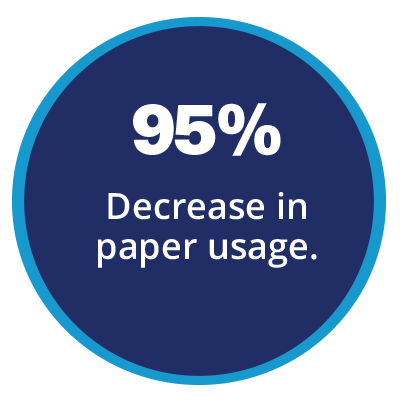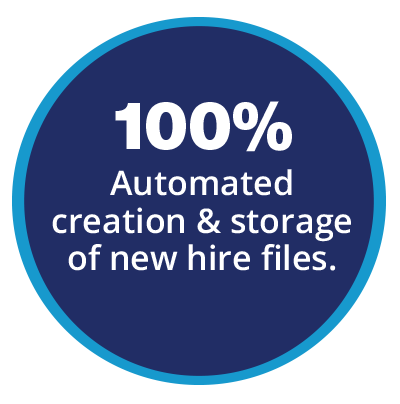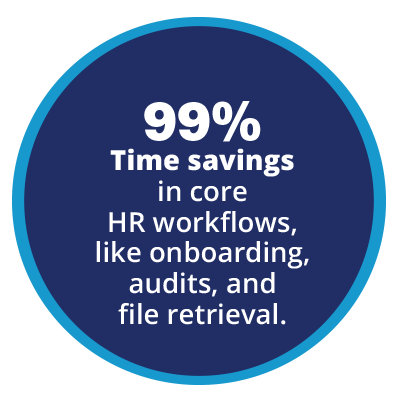How secure document management systems protect employee records and ensure compliance in hospitals and healthcare organizations

Healthcare is a prime target for ransomware. In 2023, the Department of Health and Human Services recorded 725 large healthcare data breaches, each involving 500 or more records. That is nearly two a day, and the highest number since federal reporting began. Hacking and ransomware incidents were responsible for 81 percent of those breaches and exposed more than 259 million records.
Most headlines focus on patient care systems and electronic health records. Yet HR departments in healthcare organizations are just as vulnerable. Employee files contain Social Security numbers, payroll information, credentials, and even protected health information. A compromised HR filing system can lead to identity theft, financial fraud, compliance penalties, and long-term reputational damage.
Why healthcare HR files are a prime target
- High-value data such as identifiers and banking details
- Compliance risks tied to HIPAA, OSHA, and employment laws
- Reliance on paper or outdated digital systems with limited security
- Expanded risk from hybrid and remote access points
How a healthcare document management system strengthens defense
A secure document management system for healthcare industry HR files provides layered protection that outdated filing systems cannot.
Key capabilities include:
- Granular access permissions so only authorized staff can view or edit files
- Encryption in transit and at rest to protect against interception
- Audit trails that log every action for compliance reviews and accountability
- Automated retention rules that securely archive or dispose of expired records
- Encrypted external sharing that replaces risky email attachments
Proof from healthcare organizations
Healthcare providers using DynaFile have strengthened security while improving efficiency.
MorningStar Senior Living eliminated paper files and gained secure role-based access across multiple facilities. Their digital transformation reduced manual handling while ensuring compliance. Read the Case Study
BioTelemetry centralized HR records for thousands of employees using DynaFile. The move improved access control and ensured HIPAA-level security. Read the Case Study
These examples show how a healthcare document management system not only defends against cyber threats but also strengthens compliance readiness.
Frequently Asked Questions about Healthcare HR Document Management and Ransomware
Q: What makes healthcare HR files a target for ransomware?
A: Employee records hold Social Security numbers, payroll data, licenses, certifications, and sometimes protected health information (PHI). This sensitive information can be exploited for fraud, making HR systems as valuable to attackers as patient records.
Q: How does a document management system protect HR records in healthcare?
A: A healthcare-ready document management system uses encryption, role-based access controls, and audit trails to secure files. It also automates retention schedules so outdated records are removed, reducing exposure.
Q: Is a cloud-based document management system safe for HR in healthcare?
A: Yes. When built with HIPAA-level security, cloud systems provide more protection than paper files or legacy servers. They include encryption, monitoring, and secure access from any location.
Q: What compliance risks do HR leaders face if records are breached?
A: A breach can trigger HIPAA violations, OSHA penalties, state data privacy fines, and reputational harm. Strong document management reduces these risks by ensuring HR files are secured and monitored.
Q: How does DynaFile help healthcare organizations stay secure?
A: DynaFile provides healthcare HR teams with secure file storage, granular permissions, audit-ready reporting, and integrations with e-signature and HRIS tools. Case studies from MorningStar Senior Living and BioTelemetry show how it improves both compliance and efficiency.
Q: How can teaching hospitals benefit from a healthcare HR document management system?
A: Teaching hospitals face unique challenges because they manage employee files for clinical staff, faculty, residents, and students. A healthcare document management system centralizes these records in one secure platform. HR leaders gain granular access controls for different groups, audit trails for compliance reviews, and faster onboarding workflows for rotating staff and trainees. This ensures both workforce compliance and operational efficiency in complex academic medical environments.
The HR takeaway
Ransomware threats in healthcare are increasing. HR leaders must treat employee record security with the same urgency as patient records. A cloud-based electronic document management system for healthcare simplifies audits, enforces compliance, and protects sensitive employee files.
DynaFile is built for HR in high-risk industries such as healthcare. With advanced security controls, audit-ready reporting, and seamless integrations, it ensures employee records remain secure and accessible only to the right people.
Is your healthcare HR document management ready for today’s ransomware threats?
Schedule a demo today to see how DynaFile protects your workforce files.







